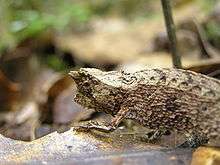Brookesia
Brookesia is a genus of chameleons, endemic to Madagascar, that range from small to very small in size, and are known collectively as leaf chameleons (though this name also commonly is used for species in the genera Rieppeleon and Rhampholeon). Brookesia includes species considered to be the world's smallest chameleons, and are also among the smallest reptiles. Members of the genus Brookesia are largely brown and most are essentially terrestrial.
| Brookesia | |
|---|---|
 | |
| Scientific classification | |
| Kingdom: | Animalia |
| Phylum: | Chordata |
| Class: | Reptilia |
| Order: | Squamata |
| Suborder: | Iguania |
| Family: | Chamaeleonidae |
| Subfamily: | Brookesiinae |
| Genus: | Brookesia Gray, 1864 |
| Type species | |
| Chamaeleo superciliaris Kuhl, 1820 | |
| Diversity | |
| 30 species | |
A significant percentage of the species in the genus were only identified to science within the last three decades, and a number of species that still have not received a scientific name are known to exist. Most inhabit very small ranges in areas that are difficult to access, and due to their small size and secretive nature, they have been relatively poorly studied compared to their larger relatives.
Brookesia are abundant in low-disturbance riparian zones[1] and low-disturbance rainforests. Brookesia are scarce in high-disturbance forests[2] recovering from burning.
Etymology
The generic name Brookesia is in honor of British naturalist Joshua Brookes.[3]
Conservation status
Most Brookesia are on CITES Appendix II, the only exception being B. perarmata on Appendix I (a species also listed as endangered by IUCN). Consequently, a special permit is required to import any of the below species from their native Madagascar, and typically no permit is issued for B. perarmata.
Species

.png)
The genus Brookesia contains the following 30 species which are recognized as being valid.[5]
- Brookesia antakarana Raxworthy & Nussbaum, 1995
- Brookesia bekolosy Raxworthy & Nussbaum, 1995
- Brookesia betschi Brygoo, Blanc & Domergue, 1974 – Blanc's leaf chameleon
- Brookesia bonsi Ramanantsoa, 1980
- Brookesia brunoi Crottini et al., 2012
- Brookesia brygooi Raxworthy & Nussbaum, 1995 – leaf chameleon or Brygoo's chameleon
- Brookesia confidens Glaw et al., 2012[4]
- Brookesia decaryi, Angel, 1939 – spiny leaf chameleon
- Brookesia dentata Mocquard, 1900
- Brookesia desperata Glaw et al., 2012[4]
- Brookesia ebenaui (Boettger, 1880) – northern leaf chameleon
- Brookesia exarmata Schimmenti & Jesu, 1996
- Brookesia griveaudi Brygoo, Blanc & Domergue, 1974
- Brookesia karchei Brygoo, Blanc & Domergue, 1970 – naturelle leaf chameleon
- Brookesia lambertoni Brygoo & Domergue, 1970 – Fito leaf chameleon
- Brookesia lineata Raxworthy & Nussbaum, 1995
- Brookesia micra Glaw et al., 2012[4]
- Brookesia minima Boettger, 1893 – minute leaf chameleon
- Brookesia perarmata (Angel, 1933) – Antsingy leaf chameleon
- Brookesia peyrierasi Brygoo & Domergue, 1974 – Peyrieras' leaf chameleon
- Brookesia ramanantsoai Brygoo & Domergue, 1975 – Ramanantsoa's minute leaf chameleon
- Brookesia stumpffi Boettger, 1894 – plated leaf chameleon
- Brookesia superciliaris (Kuhl, 1820) – brown leaf chameleon
- Brookesia tedi Scherz, J. Kohler, Rakotoarison, Glaw & Vences, 2019
- Brookesia therezieni Brygoo & Domergue, 1970 – Perinet leaf chameleon
- Brookesia thieli Brygoo & Domergue, 1969 – Domergue's leaf chameleon
- Brookesia tristis Glaw et al., 2012[4]
- Brookesia tuberculata Mocquard, 1894 Amber Mountain leaf chameleon
- Brookesia vadoni Brygoo & Domergue, 1968 – Iaraka River leaf chameleon or mossy pygmy leaf chameleon
- Brookesia valerieae Raxworthy, 1991 – Raxworthy's leaf chameleon
Nota bene: A binomial authority in parentheses indicates that the species was originally described in a genus other than Brookesia.
See also
- Island dwarfism
References
- "Forest disturbance and river proximity influence chameleon abundance in Madagascar". Biological Conservation. doi:10.1016/S0006-3207(02)00166-0.
- "A Rainforest Survey of Amphibians, Reptiles and Small Mammals at Montagne D'Ambre, Madagascar". Biological Conservation. doi:10.1016/0006-3207(94)90329-8.
- Beolens, Bo; Watkins, Michael; Grayson, Michel (2011). The Eponym Dictionary of Reptiles. Baltimore: Johns Hopkins University Press. xiii + 296 pp. ISBN 978-1-4214-0135-5. (Genus Brookesia, p. 40).
- Glaw F; Köhler J; Townsend TM; Vences M (2012). "Rivaling the World's Smallest Reptiles: Discovery of Miniaturized and Microendemic New Species of Leaf Chameleons (Brookesia) from Northern Madagascar". PLoS ONE. 7 (2): e31314. doi:10.1371/journal.pone.0031314. PMC 3279364. PMID 22348069.
- Genus Brookesia at The Reptile Database. www.reptile-database.org
Further reading
- Gray JE (1864). "Revision of the Genera and Species of Chamæleonidæ, with the Description of some New Species". Proc. Zool. Soc. London 1864: 465-477 + Plates XXXI & XXXII. (Brookesia, new genus, pp. 476–477).
External links
| Wikimedia Commons has media related to Brookesia. |
| Wikispecies has information related to Brookesia |
- CITES: Appendices I, II and III. Accessed 23-01-2009.
- Glaw F, Vences M (2007). A Field Guide to the Amphibians and Reptiles of Madagascar, Third Edition. Cologne, Germany: Vences & Glaw Verlag. 496 pp. ISBN 978-3-929449-03-7.